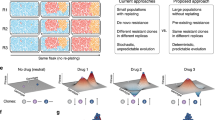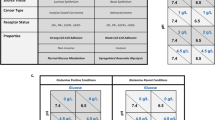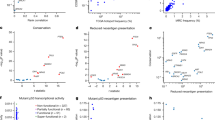Abstract
Heterogeneity in strategies for survival and proliferation among the cells that constitute a tumour is a driving force behind the evolution of resistance to cancer therapy. The rules mapping the tumour’s strategy distribution to the fitness of individual strategies can be represented as an evolutionary game. We develop a game assay to measure effective evolutionary games in co-cultures of non-small cell lung cancer cells that are sensitive and resistant to the anaplastic lymphoma kinase inhibitor alectinib. The games are not only quantitatively different between different environments, but targeted therapy and cancer-associated fibroblasts qualitatively switch the type of game being played by the in vitro population from Leader to Deadlock. This observation provides empirical confirmation of a central theoretical postulate of evolutionary game theory in oncology: we can treat not only the player, but also the game. Although we concentrate on measuring games played by cancer cells, the measurement methodology we develop can be used to advance the study of games in other microscopic systems by providing a quantitative description of non-cell-autonomous effects.
This is a preview of subscription content, access via your institution
Access options
Access Nature and 54 other Nature Portfolio journals
Get Nature+, our best-value online-access subscription
$29.99 / 30 days
cancel any time
Subscribe to this journal
Receive 12 digital issues and online access to articles
$119.00 per year
only $9.92 per issue
Buy this article
- Purchase on Springer Link
- Instant access to full article PDF
Prices may be subject to local taxes which are calculated during checkout




Similar content being viewed by others
Code availability
Image analysis code is available on GitHub at https://github.com/kaznatcheev/CV4Microscopy. The game assay analysis code is available on GitHub at https://github.com/kaznatcheev/GameAssay.
Data availability
Due to size constraints, raw image data from experiments are available upon request. Post-image processing data (that is, population size time-series for each experimental replicate) are available on GitHub at https://github.com/kaznatcheev/GameAssay.
References
Merlo, L. M. F., Pepper, J. W., Reid, B. J. & Maley, C. C. Cancer as an evolutionary and ecological process. Nat. Rev. Cancer 6, 924–935 (2006).
Heppner, G. H. Tumor heterogeneity. Cancer Res. 44, 2259–2265 (1984).
Ibrahim-Hashim, A. et al. Defining cancer subpopulations by adaptive strategies rather than molecular properties provides novel insights into intratumoral evolution. Cancer Res. 77, 2242–2254 (2017).
Scott, J. & Marusyk, A. Somatic clonal evolution: a selection-centric perspective. Biochim. Biophys. Acta 1867, 139–150 (2017).
Shaw, A. T. et al. Crizotinib versus chemotherapy in advanced ALK-positive lung cancer. N. Engl. J. Med. 368, 2385–2394 (2013).
Peters, S. et al. Alectinib versus crizotinib in untreated ALK-positive non-small-cell lung cancer. N. Engl. J. Med. 377, 829–838 (2017).
Shaw, A. T. & Engelman, J. A. ALK in lung cancer: past, present, and future. J. Clin. Oncol. 31, 1105–1111 (2013).
Gillies, R. J., Verduzco, D. & Gatenby, R. A. Evolutionary dynamics of carcinogenesis and why targeted therapy does not work. Nat. Rev. Cancer 12, 487–493 (2012).
Katayama, R., Lovly, C. M. & Shaw, A. T. Therapeutic targeting of anaplastic lymphoma kinase in lung cancer: a paradigm for precision cancer medicine. Clin. Cancer Res. 21, 2227–2235 (2015).
Marusyk, A. et al. Spatial proximity to fibroblasts impacts molecular features and therapeutic sensitivity of breast cancer cells influencing clinical outcomes. Cancer Res. 76, 6495–6506 (2016).
Yamada, T. et al. Paracrine receptor activation by microenvironment triggers bypass survival signals and ALK inhibitor resistance in EML4–ALK lung cancer cells. Clin. Cancer Res. 18, 3592–3602 (2012).
Ou, S.-H. I. et al. Alectinib in crizotinib-refractory ALK-rearranged non-small-cell lung cancer: a phase II global study. J. Clin. Oncol. 34, 661–668 (2015).
Dhawan, A. et al. Collateral sensitivity networks reveal evolutionary instability and novel treatment strategies in ALK mutated non-small cell lung cancer. Sci. Rep. 7, 1232 (2017).
Seto, T. et al. CH5424802 (RO5424802) for patients with ALK-rearranged advanced non-small-cell lung cancer (AF-001JP study): a single-arm, open-label, phase 1–2 study. Lancet Oncol. 14, 590–598 (2013).
Kaznatcheev, A. Two conceptions of evolutionary games: reductive vs effective. Preprint at https://www.biorxiv.org/content/early/2017/12/11/231993 (2017).
Kaznatcheev, A. Effective games and the confusion over spatial structure. Proc. Natl Acad. Sci. USA 115, E1709 (2018).
Marusyk, A. et al. Non-cell autonomous tumor-growth driving supports sub-clonal heterogeneity. Nature 514, 54–58 (2014).
Basanta, D. et al. Investigating prostate cancer tumour–stroma interactions: clinical and biological insights from an evolutionary game. Br. J. Cancer 106, 174–181 (2012).
Kaznatcheev, A., Scott, J. G. & Basanta, D. Edge effects in game-theoretic dynamics of spatially structured tumours. J. R. Soc. Interface 12, 20150154 (2015).
Kaznatcheev, A., Vander Velde, R., Scott, J. G. & Basanta, D. Cancer treatment scheduling and dynamic heterogeneity in social dilemmas of tumour acidity and vasculature. Br. J. Cancer 116, 785–792 (2017).
Kerr, B., Riley, M. A., Feldman, M. W. & Bohannan, B. J. M. Local dispersal promotes biodiversity in a real-life game of rock–paper–scissors. Nature 418, 171–174 (2002).
Maddamsetti, R., Lenski, R. E. & Barrick, J. E. Adaptation, clonal interference, and frequency-dependent interactions in a long-term evolution experiment with Escherichia coli. Genetics 200, 619–631 (2015).
MacLean, R. C. & Gudelj, I. Resource competition and social conflict in experimental populations of yeast. Nature 441, 498–501 (2006).
Gore, J., Youk, H. & Van Oudenaarden, A. Snowdrift game dynamics and facultative cheating in yeast. Nature 459, 253–256 (2009).
Li, X.-Y. et al. Which games are growing bacterial populations playing? J. R. Soc. Interface 12, 20150121 (2015).
Archetti, M., Ferraro, D. A. & Christofori, G. Heterogeneity for IGF-II production maintained by public goods dynamics in neuroendocrine pancreatic cancer. Proc. Natl Acad. Sci. USA 112, 1833–1838 (2015).
Maynard Smith, J. & Price, G. R. The logic of animal conflict. Nature 246, 15–18 (1973).
Tomlinson, I. P. & Bodmer, W. F. Modelling the consequences of interactions between tumour cells. Br. J. Cancer 75, 157–160 (1997).
Tomlinson, I. P. Game-theory models of interactions between tumour cells. Eur. J. Cancer 33, 1495–1500 (1997).
Archetti, M. Evolutionary game theory of growth factor production: implications for tumour heterogeneity and resistance to therapies. Br. J. Cancer 109, 1056–1062 (2013).
Peña, J., Lehmann, L. & Nöldeke, G. Gains from switching and evolutionary stability in multi-player matrix games. J. Theor. Biol. 346, 23–33 (2014).
Robinson, D. & Goforth, D. The Topology of the 2 × 2 Games: a New Periodic Table Vol. 3 (Psychology Press, New York, 2005).
Rapoport, A. Exploiter, leader, hero, and martyr: the four archetypes of the 2 × 2 game. Syst. Res. Behav. Sci. 12, 81–84 (1967).
Anderson, A. R. A., Weaver, A. M., Cummings, P. T. & Quaranta, V. Tumor morphology and phenotypic evolution driven by selective pressure from the microenvironment. Cell 127, 905–915 (2006).
Nichol, D. et al. Steering evolution with sequential therapy to prevent the emergence of bacterial antibiotic resistance. PLoS Comput. Biol. 11, e1004493 (2015).
Basanta, D., Scott, J. G., Rockne, R., Swanson, K. R. & Anderson, A. R. A. The role of IDH1 mutated tumour cells in secondary glioblastomas: an evolutionary game theoretical view. Phys. Biol. 8, 015016 (2011).
Gatenby, R. A., Gawlinski, E. T., Gmitro, A. F., Kaylor, B. & Gillies, R. J. Acid-mediated tumor invasion: a multidisciplinary study. Cancer Res. 66, 5216–5223 (2006).
Jain, R. K. Normalizing tumor microenvironment to treat cancer: bench to bedside to biomarkers. J. Clin. Oncol. 31, 2205–2218 (2013).
Zhang, J., Cunningham, J. J., Brown, J. S. & Gatenby, R. A. Integrating evolutionary dynamics into treatment of metastatic castrate-resistant prostate cancer. Nat. Commun. 8, 1816 (2017).
Gerlee, P. & Altrock, P. M. Extinction rates in tumour public goods games. J. R. Soc. Interface 14, 20170342 (2017).
Conitzer, V. The exact computational complexity of evolutionarily stable strategies. In International Conference on Web and Internet Economics 96–108 (Springer, 2013).
Kaznatcheev, A. Computational complexity as an ultimate constraint on evolution. Preprint at https://www.biorxiv.org/content/early/2018/06/18/187682 (2018).
Mediavilla-Varela, M., Boateng, K., Noyes, D. & Antonia, S. J. The anti-fibrotic agent pirfenidone synergizes with cisplatin in killing tumor cells and cancer-associated fibroblasts. BMC Cancer 16, 176 (2016).
Acknowledgements
J.G.S. acknowledges the NIH Loan Repayment Programs for generous support of his research in general, as well as Miles for Moffitt and the NIH Case Comprehensive Cancer Center (support grant P30CA043703), and the Calabresi Clinical Oncology Research Program, National Cancer Institute (award number K12CA076917). We also thank M. Abazeed, P. Jeavons and K. Kaznatcheev for helpful feedback and discussions.
Author information
Authors and Affiliations
Contributions
A.K., J.P., A.M. and J.G.S. conceived and designed the study. J.P. and A.M. performed the experiments. A.K. designed the mathematical model, wrote the image analysis and game assay code, and analysed the data. A.K., A.M. and J.G.S. wrote the main text. A.K. and J.P. wrote the Supplementary Information. D.B., A.M. and J.G.S. supervised the project. All authors discussed the results and implications, commented on the work at all stages and approved the final submission.
Corresponding authors
Ethics declarations
Competing interests
The authors declare no competing interests.
Additional information
Publisher’s note: Springer Nature remains neutral with regard to jurisdictional claims in published maps and institutional affiliations.
Supplementary information
Supplementary Information
Supplementary Sections A–F, including Supplementary Figures 1–8 and Supplementary References
Rights and permissions
About this article
Cite this article
Kaznatcheev, A., Peacock, J., Basanta, D. et al. Fibroblasts and alectinib switch the evolutionary games played by non-small cell lung cancer. Nat Ecol Evol 3, 450–456 (2019). https://doi.org/10.1038/s41559-018-0768-z
Received:
Accepted:
Published:
Issue Date:
DOI: https://doi.org/10.1038/s41559-018-0768-z
This article is cited by
-
Understanding and leveraging phenotypic plasticity during metastasis formation
npj Systems Biology and Applications (2023)
-
Effective dose window for containing tumor burden under tolerable level
npj Systems Biology and Applications (2023)
-
Drug dependence in cancer is exploitable by optimally constructed treatment holidays
Nature Ecology & Evolution (2023)
-
Evolutionary Games and Applications: Fifty Years of ‘The Logic of Animal Conflict’
Dynamic Games and Applications (2023)
-
Spatial cumulant models enable spatially informed treatment strategies and analysis of local interactions in cancer systems
Journal of Mathematical Biology (2023)



